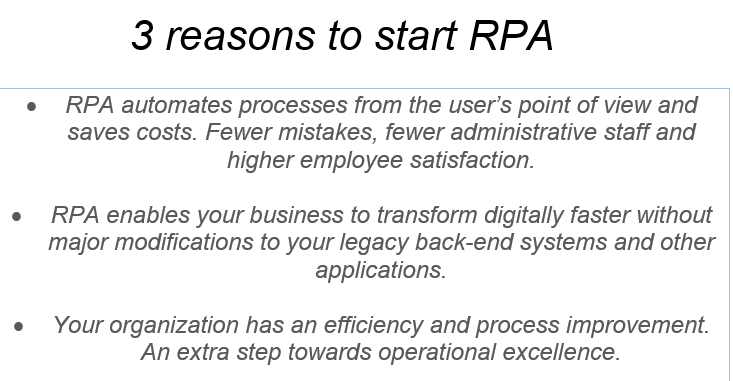RPA: Why should you consider automation to achieve operational excellence

As we are moving towards rapid development, every business is becoming “intelligent” and constantly finding new ways to reinvent their products and services, amaze their customers, and increase profits. To survive in today’s competitive world, companies of all shapes and sizes are integrating automation into their infrastructure, some of them succeed while others fail. According to Forrester, European businesses will invest between €2.4 and €3.3 billion in automation to boost productivity, including in lower-wage sectors.
Higher production and increased productivity are the two biggest advantages commonly attributed to automation. Other benefits related to automation are eliminating or reducing risks of human error on manual data entry tasks to ensure consistent quality in data entry. As businesses today collect enormous amounts of data, automation software can easily track all insights hidden in large portions of, often unused, data.
To start with automation, businesses must ask themselves, what are the goals they want to achieve with automation? Which process do they need to automate? Do they have automation tools and experts? What skills do their staff need to work in an automated environment?
Here below is a checklist you need to know before adding automation into your ecosystem:
-
- Companies must know the goals that they want to achieve by implementing automation in their workflow. They can achieve their goals to make more profit, reduce overall operational costs or get the maximum work done in a minimum time, or efficiently utilize available resources and take appropriate strategic decisions. Once their goal and vision are clear, achieving results is easy and possible.
-
- Once the goal is clear, the automation of necessary tasks must be number one on the priority list. At this point, the time, budget and human resources must be well calculated respecting the business process, also these three are the main resources and assets that can be saved once the automation process is placed.
-
- Develop a roadmap that strategically focuses on investments that are needed to create a digital environment.
-
- According to the Robotic Process Automation (RPA) annual report 2019 by Everest Group, the global independent RPA independent software vendor market surpassed US$1 billion in 2018, with over two-thirds of the revenue coming from software licenses. It shows the availability of so many automation tools that makes it harder to select the right tool a company needs to accomplish its goals. Therefore, they must choose the one which is easy to install by their IT specialist without any extern or vendor support.
-
- Select and set up a team of employees that can implement smooth change management towards the digital workforce system instead of legacy software and create a continuous deployment plan.
-
- Train IT managers to recognize opportunities to build and adapt the automation software to their needs and establish a modern technology environment to support the rapid development and adaptation of innovative solutions.
-
- Companies that are newly introduced to automation tools/software, must keep in mind one of the most crucial factors for long-term survival, which are the running costs and licensing of tools, in addition to that make sure to opt for the tool that provides a smooth and secure data handling, as in automation processes, customer’s private or confidential information can be used.
-
- Choose the software that will scale along with your automation efforts and provide for a full-scale digital transformation.
-
- Pay attention to continuous improvement of critical business process planning and operations to develop a robust understanding of the business process and workflow and know what makes the processes tick and what doesn’t.
Once the automation strategy is placed, you can redeploy the human workforce to innovate and improve your business processes and deal with other priorities.
Sources :
